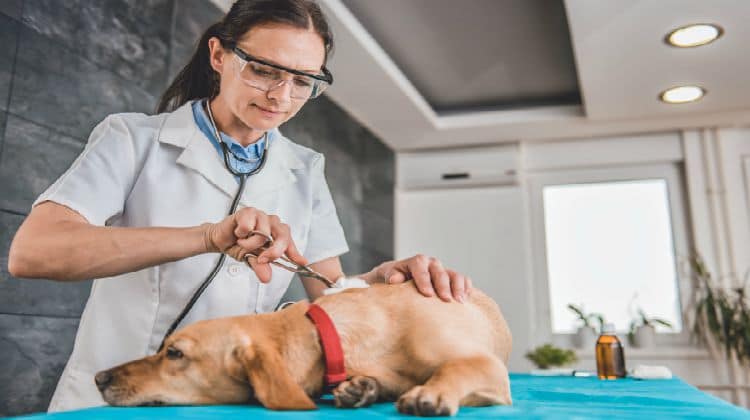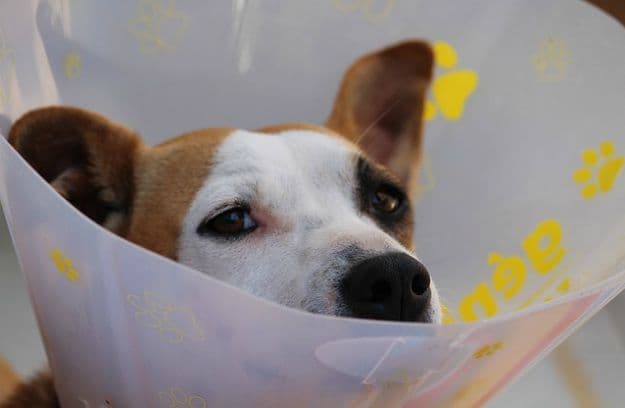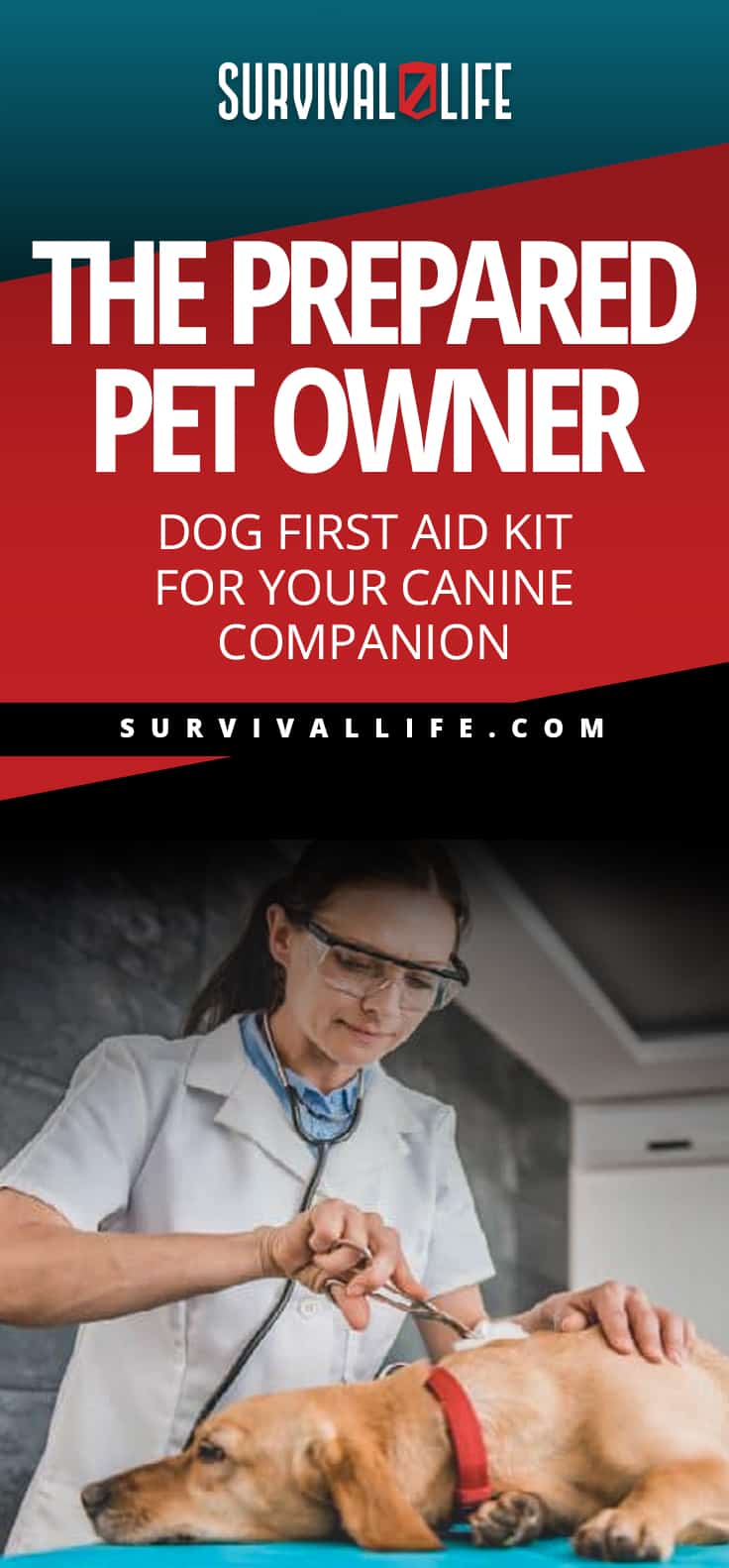Featured Articles
Dog First Aid Kit For Your Canine Companion | The Prepared Pet Owner

Here at Survival Life, we cover the importance of first aid kits often. In my opinion, they are the most necessary kit anyone can carry on their travels. Whether you carry one in your car, your backpack, your purse, your bug out bag, or keep one in your home…they are essential both for you and your furry friend alike! Read on to learn about what to keep in a dog first aid kit. Be prepared for an emergency situation with your canine companion.

Dog First Aid Kit For Your Canine Companion
Our beloved canines are a big part of our lives – they are family! Whether we go on a day hike, or spend a weekend at the lake camping, there they are at our side. They are man’s best friend after all.
When you bring them on a camping trip (for example) you packed their favorite toy, their doggie bed, their food, their food/water bowls, their leash, and their favorite dog treats. But, what about a first aid kit? If you don’t have a first aid kit for your canine companion, no worries! In this article, I’ll go over everything they will need. Their first aid kits are very similar to ours with just a few differences.
I’ll also cover first aid techniques for wound care, what to do if they have a seizure, what to do if they are choking, and what steps to take if your dog has been possibly poisoned.
Disclaimer: Remember that first aid for your furry friend is NOT a substitute for veterinary care but, it may save your dog’s life until they can receive medical treatment from a veterinarian.
First Aid Items for Man’s Best Friend:
- Hydrogen Peroxide
- Antiseptic Solution
- Small Flashlight
- Tweezers
- Gauze Tape
- Gauze Pads
- Cotton Balls
- Q-tips
- Scissors
- Instant Cold Pack and Instant Hot Pack
- Hand Sanitizer
- Latex Gloves
- Alcohol Pads
- Dog Aspirin (Can be found in the pet section at your local Wal-Mart)
- Any prescriptions that your dog takes on a daily basis
- Soft Blanket
- A muzzle (Even the best tempered dogs can bite when they are in pain)
Other items to consider for their first aid kit are:
- Your dog’s complete medical records including recent vaccinations
- Phone number of your dog’s veterinarian
- The phone number for an emergency veterinary hospital (When traveling make sure to include an emergency clinic in the area of where you’re going to be)
- Phone numbers for Poison Control: Animal Poison Control (ASPCA) (888) 426-4435. National Animal Poison Control Center (800) 548-2423.
First Aid Techniques
If your canine companion becomes injured it is important that you learn the basics of first aid techniques. As I said before, these techniques are not to take the place of veterinary care but, these techniques can save your dog’s life until they are able to receive medical treatment.
Wound Care
- Clean area with hydrogen peroxide using cotton balls. (You can use alcohol swabs but, it will most likely sting which will possibly make your dog jumpy and/or slightly aggressive, which will make it more difficult to dress their wound.)
- Place pressure with gauze or a clean cloth to stop any bleeding.
- If there is debris, flush the wound with clean water.
- For deep wounds, or severe bleeding, keep pressure on the wound until you can get your dog to a veterinarian.
Seizure Care
- The most important thing is to protect them from self-injury.
- DO NOT place your fingers or any object in your pet’s mouth.
- Clear the area around your pet to help prevent injury during the seizure.
- DO NOT attempt to restrain your pet but, you can place a hand on their body.
- When the seizure has stopped, contact your veterinarian immediately for further instructions.
- If the seizure does not stop within 3 to 5 minutes or if your dog comes out of the seizure and goes into another one within an hour, transport your dog immediately to the nearest veterinarian!
What To Do If They Are Choking
- If your dog is choking, hold their upper jaw open with one hand and look for the object that they are choking on.
- Unless you can clearly see and grasp the object, DO NOT put your fingers into the dog’s mouth or throat.
- With smaller dogs, lift their back legs into the air so gravity can help dislodge the object.
- If you can’t remove the object, using the heel of your hand, deliver 4-5 sharp blows on your dog between their shoulder blades.
What To Do If You Suspect Your Dog Has Been Poisoned
- If you suspect poisoning, seek care immediately.
- If you cannot get to the veterinarian right away, call poison control immediately! Again the phone numbers for poison control are: Animal Poison Control (ASPCA) (888) 426-4435. National Animal Poison Control Center (800) 548-2423.
Check out my previous articles, How to Prepare Bug Out Bags for Your Beloved Pets and If You’re Cold, Your Pets Are Too | Keeping Your Pets Safe in the Winter to keep your pets prepared, warm, and safe!

For awesome survival gear you can’t make at home, check out the Survival Life Store!
Are you in need of some dog first aid kit supplies? Check out a few of these options:
- If you're looking for an all-inclusive Pet First Aid Kit, this is for you!
- Maybe you need something a little more concise to take with you on daily hikes with your best friend. Check out this Canine Friendly Pocket Pet First Aid Kit
- If you want to be able to better identify the symptoms of your dog, then this book, Dog First Aid: A Field Guide to Emergency Care for the Outdoor Dog, is perfect for you.
-

 Paracord Projects1 year ago
Paracord Projects1 year agoParacord Projects | 36 Cool Paracord Ideas For Your Paracord Survival Projects
-

 Paracord Projects1 year ago
Paracord Projects1 year agoHow To Make Paracord Survival Bracelets | DIY Survival Prepping
-

 Medical Care1 year ago
Medical Care1 year ago21 Home Remedies For Toothache Pain Relief
-

 Knife Laws1 year ago
Knife Laws1 year agoAre Switchblades Legal? Knife Laws By State
-

 Do It Yourself1 year ago
Do It Yourself1 year agoSurvival DIY: How To Melt Aluminum Cans For Casting






Pingback: Fido On The Hunt: A Complete Guide To Dog Hunting Gear – Ultimate Survival Alerts
Pingback: Planning For Pets During A Disaster – The Self-Sufficient Life
Pingback: Planning For Pets During A Disaster – Sprent Brass
Pingback: Planning For Pets During A Disaster – Alive After USA Fall
Pingback: Planning For Pets During A Disaster – Bulletproof Survivors